![]()
![]()
![]()
Use LEFT and RIGHT arrow keys to navigate between flashcards;
Use UP and DOWN arrow keys to flip the card;
H to show hint;
A reads text to speech;
119 Cards in this Set
- Front
- Back
|
What are the 4 levels of awareness
|
-Unaware
-Aware -Alert -Alarm |
|
|
What are the characteristics of being unaware
|
One is not alert to the immediate environment.
-sleeping -watching TV -cooking -housework -fatigue -inebriated |
|
|
What are the characteristics of being aware
|
a person is conscious of his or her surroundings and of those persons around him or her.
|
|
|
What is the goal for awareness
|
You want to develop an unforced, unconscious alertness to your surroundings. This is in contrast to having feelings of paranoia or excessive vigilance.
|
|
|
What initiates the alert state
|
An individual in the alert level has identified a specific threat or threats.
|
|
|
What are some examples of potential threats in the home
|
-a knock on the door
-the approach of a stranger -an unexpected noise -a door-to-door salesperson, solicitor, or survey taker -a stranger asking for assistance, or to use the telephone -an unfamiliar car with people inside, parked in front of your house |
|
|
T/F
As a general rule, any person not known to the resident of the house constitute a potential threat, no matter who they seem or claim to be. |
True
|
|
|
alert level involves identification of a specific ___ threat
|
potential
|
|
|
What are the triggers that initiate the alarm state
|
the potential threat identified in the alert stage has crossed one or more of the thresholds previously established, and has become a real threat to your safety.
|
|
|
What are the two steps that should be taken when at the alert level
|
Step 1: formulate a hypothetical plan of action to respond to the threat. It's always quicker to act than react. It's also important to always have more than 1 plan of action.
Step 2: Establish a "threshold stimulus" that will initiate a plan of action. |
|
|
What are some typical threshold stimuli
|
-the approach of a potential threat within a certain distance
-the refusal of a threat to depart when told to leave -the presentation of a weapon by the threat -an overt gesture or statement from the threat indicating an intention to do harm |
|
|
What is one of the most important personal protection tool you possess
|
Your powers of awareness
|
|
|
Why is your power of awareness so important
|
It may enable you to escape, evade, avoid, or deter an attack rather than resolving it through the use of force.
|
|
|
T/F
If you fail to maintain a state of awareness, you are more likely to become a victim of an attack, or to have to use deadly force to defend yourself. |
True
|
|

This position is called the
|
Forward Punch position
|
|

This position is called the
|
High Double Kneeling position
|
|

This position is called the
|
Kneeling High Position
|
|
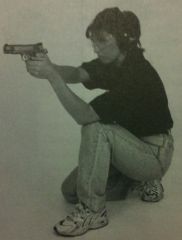
This position is called the
|
Low Kneeling position
|
|
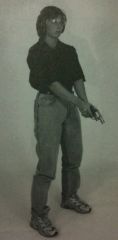
This position is called the
|
Low Ready position
|
|
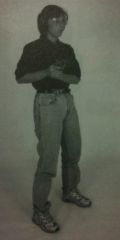
This position is called the
|
Retention Ready position
|
|
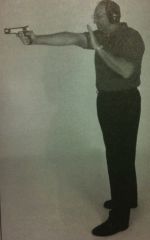
This position is called the
|
Reverse Punch position
|
|

This position is called the
|
Squatting position
|
|
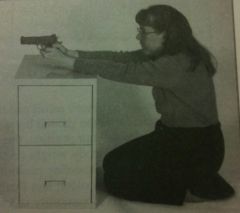
This position is called the
|
Supported Knee position
|
|
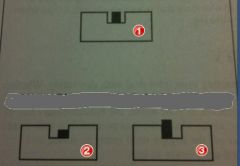
What is the difference between sight alignment #1 and alignments #2 and #3
|
#1 is an ideal sight alignment.
#2 and #3 are defensive sight alignments. |
|
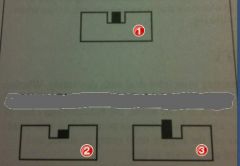
What is the theory of the sight alignments #2 and #3
|
In defensive sight alignment, you may fire whenever the post is visible somewhere in the notch.
|
|
|
In a defensive situation, what is the proper method of breath control
|
Simply stopping breathing and holding it. Note: while this method only works for a few seconds, it should be sufficient for the duration of a typical armed response to an attack.
|
|
|
In a defensive situation, what is the proper method of hold control
|
Hold control is achieved primarily through a well-balanced, stable shooting position that is naturally aligned with the target. The armed citizen in a defensive situation doesn't have the luxury of holding the body and gun as still as possible while the shot is being fired.
|
|
|
In a defensive situation, what is the proper method of trigger control
|
Trigger control is still critical; poor trigger technique can easily cause a shooter to completely miss even a large target at close range. Trigger control in a defensive shooting environment involves speeding up the process of squeezing the trigger without jerking or flinching. The more smoothly the shooter pulls the trigger, the less the gun's sights will be disturbed during the firing process, even when the time period of the pull is compressed for faster shooting.
|
|
|
Why is a properly placed trigger finger important even in a defensive situation
|
A properly placed trigger finger allows the force of the pull to be directed straight to the rear, minimizing a tendency to jerk the gun to the right or left.
|
|
|
In a defensive situation, where should the finger be placed on the trigger
|
the middle of the last pad of the trigger finger
|
|
|
In a defensive situation, where should the finger be placed on the trigger for double-action shooting
|
Approximately on the joint between the last and middle pads of the trigger finger.
|
|
|
T/F
the proper contact point on the trigger finger may change from gun to gun and firing position to firing position |
True
|
|
|
How can the ideal trigger finger placement be achieved
|
through dry-fire practice at a sheet of white paper. Adjust your finger position until there is no movement in sight alignment when the trigger is pulled and the hammer or striker fall.
|
|
|
Is the follow through important in a defensive situation
|
Yes, however, it is highly compressed to last only a fraction of a section.
|
|
|
What is the best way to win a confrontation
|
By avoiding a confrontation.
|
|
|
T/F
Deliberate pinpoint aiming techniques are critical when shooting defensively |
False
|
|
|
What kind of aiming technique is recommended by the NRA Basic Personal Protection in the Home Course
|
Center of exposed target mass.
|
|
|
At what distance do most defensive shootings take place
|
At close range, less than 7 yards
|
|
|
How long do most defensive shootings take
|
a few seconds
|
|
|
Describe the characteristics of a defensive shooting
|
-less than 7 yards
-dim light -concluded in a few seconds -participants are moving rapidly |
|
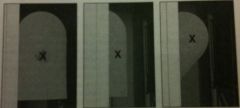
What do these photographs demonstrate
|
They demonstrate the "center of exposed mass" aiming point using targets having different degrees of exposures.
|
|
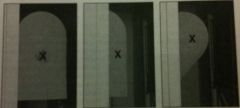
What does the 'X' represent in these photographs
|
The center of exposed target mass.
|
|
|
What are the two main requirements for storage of defensive firearms
|
1. the storage method chosen must provide an adequate level of protection to prevent unauthorized persons from accessing the firearms.
2. the storage method or device used must allow the gun to be easily retrieved as needed to defend against an intruder or an attack. |
|
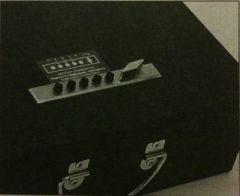
What "type" of lock is shown here
|
Simplex Lock
|
|
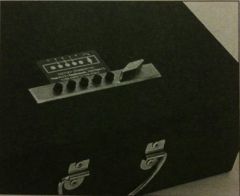
What is the advantage of this type of lock
|
It can be opened in the dark by feel
|
|
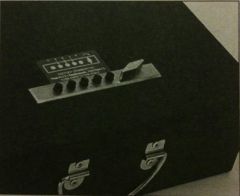
What is a potential disadvantage of this type of lock
|
the locking mechanism are usually disabled when electric power is lost (as from dead batteries or a failure in house current)
|
|
|
What does the defensive mindset consist of
|
the values, mental techniques, and attitude that maximize the effectiveness of your response to an assault.
|
|
|
What questions must you consider before contemplating the use of a firearm
|
1. Am i prepared to take a human life
2. Does my religion permit taking of life in self-defense 3. Do my moral standards permit taking of a life in self-defense. 4. Am I prepared to tolerate the judgment of family, friends, neighbors |
|
|
T/F
The willingness to take a life in self-defense is very different from the desire to take a human life |
True
|
|
|
T/F
Those who include a firearm in their personal protection plans are affirming the value of their own lives and those of their family. |
True
|
|
|
What is single most crucial factor in prevailing in a life-threatening encounter
|
the determination to persevere and win
|
|
|
What is the purpose of shooting an assailant
|
to deprive him of the ability to deliver deadly force. You shoot an attacker to stop his life-threatening attack.
|
|
|
T/F
Your goal when using deadly force is to kill your assailant |
False
Your goal is to stop the attack. |
|
|
When should you stop firing
|
Once your assailant is incapacitated or no longer presents a deadly threat.
|
|
|
What constitutes defensive accuracy
|
defensive accuracy is the level of accuracy that allows the shooter to keep all shots in an assailant's vital area.
|
|
|
If a center-of-mass hold is use on a fully exposed target, to keep all shots in an assailant's vital area requires shots to be within how big of an area
|
approximately 9 inch circle, about the size of an average paper plate.
|
|
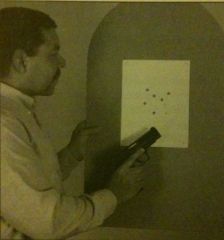
Is this grouping adequate for defensive purposes
|
Yes
|
|
|
What are some of the perceptual changes that occur during a threatening encounter
|
-tunnel vision
-auditory exclusion -time dilation |
|
|
What is tunnel vision
|
You become so focused on the perceived threat that you become virtually oblivious to anything going on elsewhere.
|
|
|
What is auditory exclusion
|
this is a condition that in a violent encounter, extraneous sounds may be inaudible.
|
|
|
What is time dilation
|
this is the perception of slowed time that occurs during extreme stress.
|
|
|
Why should you wait much longer than you may initially think is necessary before you relax your guard or emerge from hiding
|
Because you may be experiencing time dilation
|
|
|
How can you fight auditory exclusion
|
You can at least partially counteract the effects of auditory exclusion by screaming your commands to your assailant. Not only will this help break through the veil of auditory exclusion; it also serves to intimidate him.
|
|
|
How can tunnel vision be broken
|
by developing certain training habits such as lowering the firearm and assessing the area after firing at a target.
|
|
|
Why is it important to fight tunnel vision
|
because it can cause you to fail to recognize additional threats (or innocent persons) that may lurk just outside your immediate field of view.
|
|

What is the lesson to be learned from this picture
|
Be aware of persons around or behind your target.
|
|
|
T/F
It has been shown that an assailant wielding a knife even as far away as 21 feet can usually get to and injure an armed defender before the defender can stop him with a handgun. |
True
|
|
|
An unarmed person is more likely to suffer injury if he resists an attack
|
True
|
|
|
An armed person is more likely to suffer injury if he resists an attack
|
False.
|
|
|
T/F
If you cannot prevent, deter, evade, or escape a violent attack, the effective use of minimizing your chances of injury or death |
True
|
|
|
Why is it important to keep fighting, even if you sustain an injury during an attack
|
The initial wound is not likely to be fatal, However, if you stop fighting when you are first injured, you will likely receive additional injuries, possible lethal injuries.
|
|
|
What is the single most important factor in ensuring your survival in a deadly encounter
|
The indomitable will to prevail.
|
|
|
What are two methods you can use to lesson the likelihood of injury from a violent assault
|
1. Use of cover.
2. Use of distance. Combing both can be even better. |
|
|
Can relatively small objects provide cover
|
Yes, in a pinch (wastebaskets, folding chair, coffee table, card board box) can disguise your outline, preventing an attacker from immediately detecting you and giving you the advantage of surprise, however briefly. This is particularly true in low light.
|
|
|
What are some preferred objects that provide cover and concealment
|
Large objects such as sofas, file cabinets, or refrigerators
|
|
|
Is a standard sheet rock or plaster interior wall good cover
|
No, these won't even stop a .22
|
|
|
Can a 9mm or .38 penetrate a thick hardwood door
|
Yes
|
|
|
What are the best objects for cover and concealment
|
Large gun safes, free-standing iron or steel wood stoves, some older, heavier appliances
|
|
|
What does it mean to say an object provides limited cover
|
it is capable of deflecting or slowing a bullet and decreasing its injury causing potential
|
|
|
T/F
Limited cover is better than no cover at all |
True
|
|
|
Why should you always endeavor to conceal yourself behind any available object
|
the less of you an attacker sees, the less of you there is to aim at, and the harder you are to hit.
|
|
|
What should you look for when selecting a location for cover and concealment
|
Make use of natural shadows and less illuminated areas.
|
|
|
What technique should be used to minimize exposure while firing from behind cover
|
the leaning out technique
|
|
|
Why is it important to avoid resting or bracing the handgun on or against the cover
|
Contact with the cover can impede the rotation of the cylinder of a revolver or the operation of the slide of a Semi-Auto. Both can cause gun failures. Contact can also degrade accuracy.
|
|
|
What is meant by the term "point shooting"
|
Sometime an attack occurs so close and so fast that any reference to sight alignment becomes unnecessary or impossible. Point shooting is the technique used in such circumstances.
|
|
|
How do you "point shoot"
|
Simply raise or extend handgun from a ready position to your normal two-handed firing stance, with the muzzle pointed toward the center of mass of the target, and firing as soon as your arms in in the shooting position.
|
|
|
What do you focus on when "point shooting"
|
the target, specifically, you are focused on the precise area--the center of exposed mass--you want the bullet to strike.
|
|
|
What grip should be used when "point shooting"
|
the thumb-forward two-handed grip that is taught in the NRA Basic Pistol class.
|
|
|
What can you use as a frame of reference when "point shooting"
|
although you are not actively using the sights, the handgun will be at eye level and you likely will be aware of at least the rear sights in your peripheral vision. Also, you will perceive (in your peripheral vision) the general outline of the firearm, and use that outline as a visual reference to roughly align the gun with the target.
|
|
|
T/F
Typically a violent assault is ended after the first shot |
False
Several shots with a handgun are normally required to end a violent assault. |
|
|
How long do the majority of defensive shooting instructors recommend that the armed citizen shoot
|
until the assailant no longer presents a deadly threat.
|
|
|
What is the purpose of a two-shot drill when practicing
|
two-shot drills allow the simulation of multiple shot firing sequences without unduly wasting ammunition
|
|
|
How do the shooting fundamentals apply in a defensive situation
|
they still apply; they are simply compressed to allow faster shooting.
|
|
|
T/F
What should be emphasized when practicing multiple-shot drills |
True
They should emphasize both speed and accuracy |
|
|
T/F
Good trigger control is always essential, regardless of the situation |
True
Even though the trigger pull is accelerated to the point of being almost a slap, there will still be little or no gun movement or misalignment of the sights if the trigger finger is properly located on the trigger. |
|
|
What are 3 common stoppages
|
1. Failure to go into battery
2. Failure to fire 3. Failure to eject |
|
|
What single immediate action drill can be used for stoppages in large open-top ejection ports
|
Tap, Invert, Rack, Assess
|
|
|
What is the advantage of the Tap, Invert, Rack, Awareness action in a defensive situation
|
Being able to clear almost all stoppages with only one immediate action drill saves the time of having to analyze the malfunction, identify its cause, and then decide which drill will remedy it.
|
|
|
What is the purpose of inverting the pistol before racking in the Tap, Invert, Rack, Assess drill
|
Inverting the pistol and shaking the gun while the slide is momentarily held all the way back will dislodge all but the most stubborn empty case or jammed cartridge.
|
|
|
What is the purpose of Asses in the Tap, Invert, Rack, Assess action
|
Asses the target to determine if it is still a threat.
|
|
|
True/False
Tap, Invert, Rack, Assess will work with all semi-autos |
False, there are some semi-autos that it will not work.
|
|
|
What does "Failure to go into Battery" mean
|
This stoppage occurs when the slide does not return all the way forward and the cartridge is not fully seated in the chamber.
|
|
|
How can a stovepipe be cleared
|
1. Finger off the trigger
2. With support hand, reach over the top of the pistol and forcibly swap hand rearward along the top of slide from a point half-way down the barrel back toward the body. |
|
|
What precautions should be taken when sweeping a stovepipe
|
1. Keep gun pointed in safe direction
2. Finger off the trigger 3. don't put hand in front of muzzle |
|
|
After sweeping a stovepipe, should you rack the slide
|
No. Doing so may cause a double feed. Clearing a double feed requires a time-consuming remedial action.
|
|
|
What causes "Failure to go into Battery"
|
-Round gets jammed on the feed ramp
-an oversize or over-length cartridge -excessively dirty chamber |
|
|
What direction do you turn gun to to invert it during the tap, invert, rack, assess
|
Rotate toward the thumb of the shooting hand.
|
|
|
What happens on a "failure to eject"
|
a fired case is extracted partially from the chamber, but is not completely ejected from the pistol
|
|
|
What causes a "failure to eject magazine"
|
-a defective follower or deformed magazine so it wedges inside the magazine well
|
|
|
What does a faint firing pin indentation indicate
|
May be a sign of a firearm problem requiring a gunsmith's attention
|
|
|
What are the two types of Revolver malfunctions
|
1. Failure to fire
2. Failure to eject cases from the cylinder |
|
|
What are the common reasons for a "failure to fire' in a revolver
|
1. All the rounds in the cylinder have been exhausted - shooter lost count
2. Hammer falls on a cylinder that does not contain a cartridge 3. Dud cartridge, a hangfire, a misfire, 4. If 2 or 3 rounds fail, look at the primer indent, may be a problem with handgun such as a broken firing pin. |
|
|
What causes a "failure to eject" from a revolver's cylinder
|
1. Oversized or high-pressure cartridges
2. dirt in the chambers 3. roughly machined chambers |
|
|
In a defensive situation, how would you clear lodged cases from a cylinder
|
Strike ejection rod with a straight down motion. Repeat with more force if necessary.
|
|
|
What does IPSC stand for
|
International
Practical Shooting Cogfederation |
|
|
What does IPDA stand for
|
International Defensive Pistol Association.
|
|
|
What should a safe room contain
|
1. Reinforced solid door with steel reinforced frame and both live and deadbolt locks.
2. 1 point of entry (easier to defend) 3. Located on 2nd floor, if possible 4. 1 or more windows (to communicate with police) 5. fire escape ladder 6. Telephone - ideally a cellphone with a lighted dil 7. Any telephone #'s other than 911 should bout attached gree 8. /flashlight - long hnnaled can e us |
|
|
What does IPDA stand for
|
International Defensive Pistol Association.
|
|
|
What should a safe room contain
|
1. Reinforced solid door with steel reinforced frame and both live and deadbolt locks.
2. 1 point of entry (easier to defend) 3. Located on 2nd floor, if possible 4. 1 or more windows (to communicate with police) 5. fire escape ladder 6. Telephone - ideally a cellphone with a lighted dil 7. Any telephone #'s other than 911 should bout attached gree 8. /flashlight - long handled can e us 9. Firearm 10. Extra magazines and speedloaders. |

